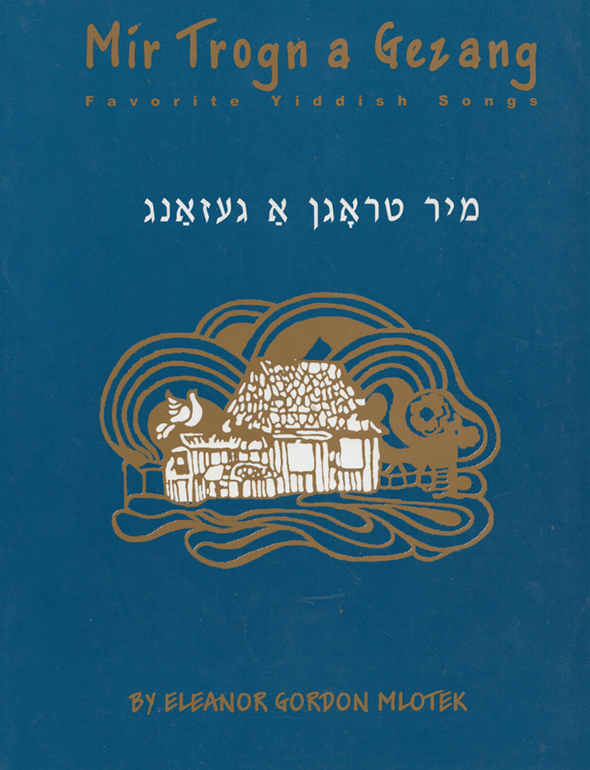This song is an adaptation of a poem by Morris Winchevsky (1856-1932), entitled “Akhdes” (Unity), in Di Kalekotke (The Rattle), published in Arbeter Fraynd Aug. 29, 1890.
Part of the original text reads: “Yo, mir zaynen ale eynik, tsu mir hobn fil tsu veynik. Un mir zaynen ale brider, un mir davnen fun eyn sider. . . Frum un link fareynikt ale, vi der khosn mit der kale, vi der khumesh mit di rashe, vi der kugl mit di kashe.” (Yes, we are all as one, whether we have much or little. And we are all brothers and pray from one prayer-book. . . Devout and leftist, united all, like the bridegroom and bride, like the Pentateuch with the Commentary, like pudding with porridge). In the 1920’s the folklorized song, much as we know it today, titled “Di Kalekotke,” was published as a folk song by the Yiddish writer and folklorist A. Litvin in Di Tsayt. Litvin notes that the song ”was the most popular folk song that was sung in the old country, mostly at Bundist parties. . . Each time it was sung something was added by each singer extemporaneously.”

And we are all brothers,
oy, oy, all brothers!
And we sing happy songs
oy, oy, oy!
And we act all together,
oy, oy, all together!
There’s nothing like it among anyone (else)
oy, oy, oy!
And we are all united
oy, oy, all united!
Though we are far too few,
oy, oy, oy!
And we do love one another
oy, oy, one another!
Like a groom and a bride,
oy, oy, oy!
And we are happy, cheerful,
oy, oy, happy, cheerful!
Singing songs, jumping for joy,
oy, oy, oy!
Un mir zaynen ale brider
Oy, oy, ale brider!
Un mir zingen freylekhe lider
Oy, oy, oy!
Un mir haltn zikh in eynem,
Oy, oy, zikh in eynem!
Azelkhes iz nito bay keynem,
Oy, oy, oy!
Un mir zaynen ale eynik,
Oy, oy, ale eynik!
Tsi mir zaynen fil tsi veynik,
Oy, oy, oy!
Un mir libn zikh dokh ale,
Oy, oy, zikh dokh ale!
Vi a khosn mit a kale, Oy, oy, oy!
Un mir zaynen freylekh, munter,
Oy, oy freylekh, munter!
Zingen lider, tantsn unter,
Oy, oy, oy!
און מיר זײַנען אַלע ברידער
אױ, אױ, אַלע ברידער!
און מיר זינגען פֿרײלעכע לידער,
אױ, אױ, אױ!
און מיר האַלטן זיך אין אײנעם,
אױ, אױ, זיך אין אײנעם!
אַזעלכעם איז נימאָ בײַ קײנעם,
אױ, אױ, אױ!
און מיר זײַנען אַלע אײניק,
אױ, אױ, אַלע אײניק!
צי מיר זײַנען פֿיל צי װײניק,
אױ, אױ, אױ!
און מיר ליבן זיך דאָך אלע,
אױ, אױ, זיך דאָך אַלץ!
װי אַ חתן מיט אַ כּלה,
אױ, אױ, אױ!
און מיר זײַנען פֿרײילעך, מונטער,
אױ, אױ, פֿרײַלעך, מונטער!
זינגען לידער, טאַנצן אונטער,
אױ, אױ, אױ!
Song Title: Ale Brider

First published in 1972, Mir Trogn A Gezang: Favorite Yiddish Songs was reprinted six more times (in 1977, 1982, 1985, 1987, 1988, 2000) due to popular demand. The songs in this anthology represent a sampling of beloved folk and well-known Yiddish songs, many of which are scattered in various song collections; some appear in very rare and inaccessible collections; and some were never before published. Folk songs comprise about a third of this volume and were selected mainly on the basis of popularity and sometimes for their historic significance. Needless to say, they are only representative of the vast, rich treasure of Yiddish folk material. The selection was made not only on the basis of personal preference, but in the knowledge they are favorites of many who sing these songs. Most of the songs represent the repertoire that was sung at Yiddish summer camps, May 1st demonstrations and at social gatherings. Many songs were introduced to American Jewry by Jewish immigrants who came to the United States after World War II, for whom these songs had been favorites in Poland and other East European communities destroyed by the Nazis.